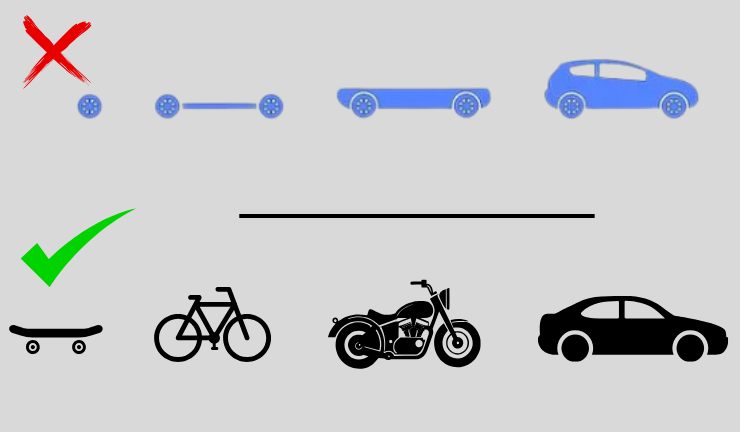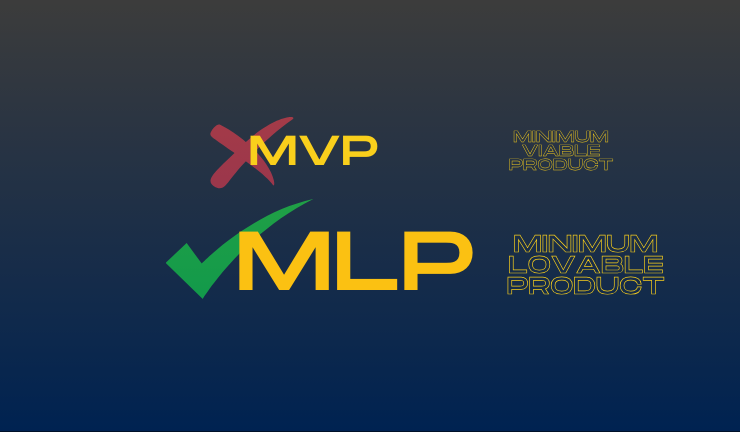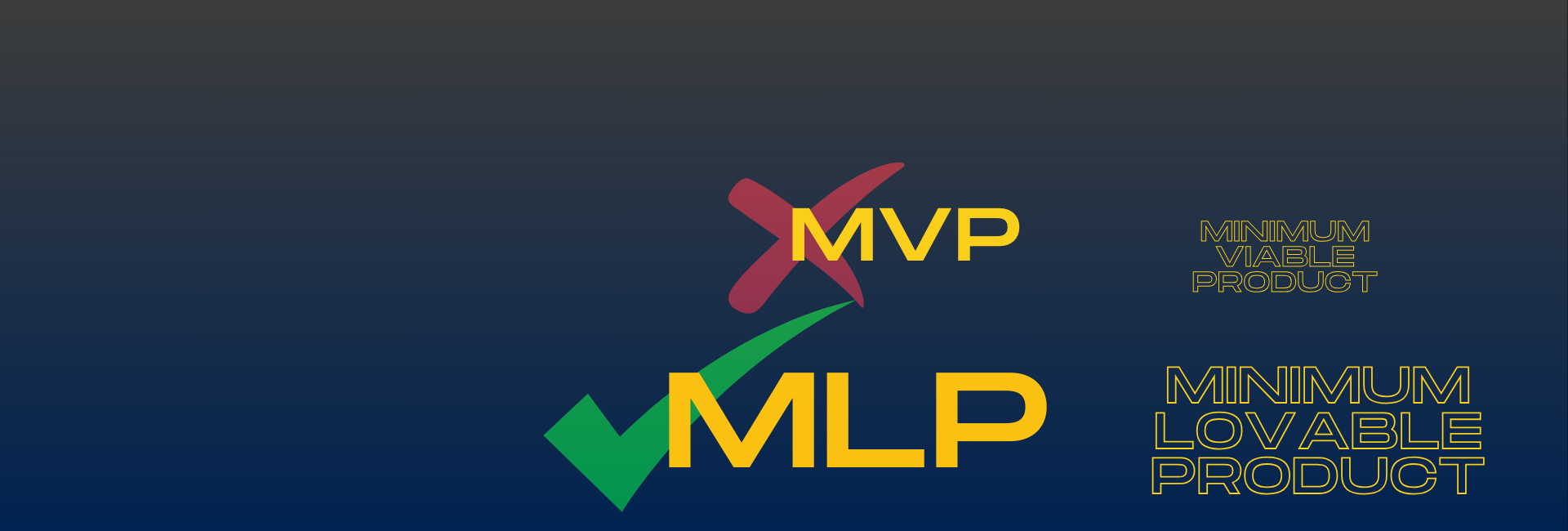For years, startup playbooks preached MVP.
“Build something quick and crappy, ship it fast, get it into users’ hands, and iterate.” It worked, 15–20 years ago. Back then, startups were competing with Excel sheets and legacy systems.
But today? Your users aren’t waiting for scraps. They have choices that to good ones. Why would they abandon something functional for a “meh” product just because you call it an MVP?
Here’s the truth.
Your customers don’t care about your lean startup process. They care about what’s best for them.
- Sometimes, best is the cheapest solution.
- Sometimes, best is laser-focused on solving one pain point brilliantly.
- Sometimes, best is a polished, high-quality digital product.
But best is never “worse than what I already have”
That old skateboard > bike > motorcycle > car analogy?

Let me explain this better and expand on this.
Why Minimum Lovable Products Are the Future
For years, the startup world has been guided by one mantra: “Build fast, ship early, and iterate.” This approach gave rise to the Minimum Viable Product MVP Development model, a strategy rooted in the idea of launching a basic, functional version of a product to test with users and refine over time. While this approach made sense in an era where startups competed against spreadsheets and outdated legacy systems, today’s landscape demands more.
Why MVPs No Longer Cut It
The MVP model was revolutionary when user expectations were low, and viable alternatives were limited. Back then, releasing a “wobbly skateboard” was acceptable because many users were still walking. However, in today’s hyper-competitive market, your audience isn’t waiting for scraps—they’ve already got cars.
With a wealth of polished and functional products already available, customers have little reason to switch to something new unless it offers undeniable value. “Viable” is no longer enough. Users expect products that are intuitive, polished, and solve their problems exceptionally well from day one.
Shifting the Mindset: From MVP to MLP
Enter the Minimum Lovable Product (MLP) model. Unlike MVPs, which prioritize function over form, MLPs focus on creating products that not only work but also delight users. The goal of an MLP isn’t just to be viable—it’s to make users feel that this product is indispensable.
Here are the three pillars of an MLP:
Lovable: The product must create an emotional connection with users. Whether through exceptional design, ease of use, or solving a problem in a way that feels almost magical, an MLP leaves users wanting more.
Valuable: The product must provide clear, tangible benefits to users. It should solve a specific pain point better than the alternatives they’re currently using.
Focused: MLPs don’t try to do everything. They solve one problem exceptionally well, rather than many problems poorly.
The Cost of Sticking to the Old MVP Model
Startups that cling to the MVP mindset risk losing user trust. A poorly executed MVP can:
Erode credibility: First impressions matter. A subpar product can turn potential customers into critics, making it harder to regain their trust.
Lose market opportunities: In a world where competitors are releasing polished solutions, an MVP that feels half-baked can lose its chance to capture attention.
Drain resources: Iterating endlessly on a weak foundation can burn time, money, and energy that could be spent building something users truly love.
Learn How to Build Products that Truly Delight your Customers
Ready to move beyond MVPs?
How to Create an MLP
Here are actionable steps to shift your focus from MVPs to MLPs:
1. Understand Your Users:
Deeply research your target audience. What are their pain points? What’s missing from the solutions they’re already using? develop a software product that directly addresses these gaps.
2. Prioritize Quality Over Speed:
While it’s important to launch quickly, speed shouldn’t come at the cost of delivering a delightful user experience. Find the right balance.
3. Focus on One Problem:
Avoid trying to solve everything at once. Zero in on one critical problem and solve it better than anyone else.
4. Validate Before Building:
Don’t assume you know what users want. Test your ideas through prototypes, surveys, or early mockups before committing to full development.
5. Polish the Experience:
Pay attention to design, usability, and overall user experience. Even if the feature set is limited, the execution should feel seamless.
6. Iterate on What Matters:
Once your MLP is in the hands of users, iterate based on meaningful feedback—not just what’s easy to fix. Focus on enhancements that increase the product’s lovability and value.
What Does This Mean for Startups?
Startups need to adjust to today’s market realities and leave the MVP mindset behind. It’s not enough to launch something that’s just functional. Instead, focus on building something lovable. Here’s how:
1. Build a Minimum Lovable Product (MLP)
An MLP is more than just “viable”—it’s a product that resonates with users and creates an emotional connection. It’s about crafting something they genuinely want to use, not just tolerate.
Ask yourself: What will make users excited about this product? What will make them feel like switching is a no-brainer?
2. Solve One Real Problem Exceptionally Well
You don’t need to solve every problem on day one. Instead, focus on doing one thing better than anyone else. Whether it’s seamless collaboration, unmatched affordability, or a feature no one else has perfected, choose your niche and own it.
When your product is exceptional in one area, it gives customers a compelling reason to choose you over existing alternatives.
3. Validate Demand Before You Build
Don’t assume you know what users want. Validate your idea before investing resources into building it. Use tools like surveys, mockups, or pre-orders to ensure there’s real demand.
More importantly, make sure your product is solving a problem that’s significant enough for customers to leave their current solution behind.
4. Pay Attention to Quality and Polish
Today’s customers have high expectations. Even if your product is solving a niche problem, it needs to look and feel professional. Intuitive design, seamless onboarding, and reliable performance are non-negotiable.
5. Iterate Smart, Not Fast
Once your MLP is in the hands of users, focus on iterating based on meaningful feedback. Rather than making changes just for the sake of it, prioritize updates that enhance the product’s value and lovability.
The Future of Startups: Build Smart, Build Lovable
The era of MVPs taught startups how to move quickly and test ideas, but today’s market demands more. The bar is higher than ever. Startups no longer have the luxury of launching rough prototypes and hoping users will stick around while they improve. Instead, the focus needs to shift to building products that users love from the start. Customers expect products that don’t just work but make them feel like they’ve found the perfect solution to their problems.
It’s not about abandoning agility or speed—it’s about balancing them with quality, polish, and a relentless focus on the user experience.
By focusing on delivering Minimum Lovable Products, you can not only capture attention but also build long-term loyalty in an increasingly competitive landscape.
So, ask yourself: Is your product just viable… or is it lovable?
What do you think? Is the MVP mindset holding back today’s startups? Let’s discuss!
If you’re looking for a digital product development partner to help you drive innovation and help you build a lovable product, ISHIR is here to help.
If you think we could be of service, please don’t hesitate to give us a shout.


